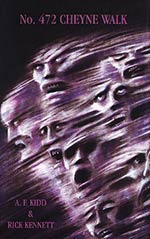
![]() Rhondak101
Rhondak101
1/19/2017
![]()
I was very excited several years ago when I discovered Caracki, The Ghost Finder on Project Gutenberg. I grew up watching Scooby Doo, and these stories were, in fact, the grandfather, or maybe great-grandfather, of that cartoon. William Hope Hodgson's stories are all very formulaic. Thomas Carnacki invites his four friends, Dodgson--the narrator and an allusion to Hodgson's own name--Arkright, Jessop, and Taylor to his house for dinner. They have a pleasurable meal, filled with the friends' chit chat. After dinner, the men retire to the fire for pipes and the story of Carnacki's latest adventure. After he finishes his story, there is minimal converstation and then the commands the group to leave (good heartedly). Hodgson only wrote nine Carnacki stories, and some of those were published posthumously because Hodgson was killed in World War I.
Like his predecessor, Sherlock Holmes, Carnacki offers a compelling character through which other stories can be told. Since Carnacki has entered the public domain, several authors have published "Carnacki" stories: William Miekle's Carnacki: Heaven and Hell (2012) and Carnacki: The Watcher at the Gate (2016) and Sam Gafford's edited collections Carnacki: The New Adventures (2013) and Carnacki: The Lost Cases (2016). The first among these other Carnacki pastisches, by more than a decade, is No. 472 Cheyne Walk: Carnacki, The Untold Stories by A. F. (Chico) Kidd and Rick Kennett (2002).
Kidd and Kennett's title reflects Carnacki's address, the place that he summons his four friends to hear his tales. The title signals their reverence for Hodgson's storytelling formula, and they continue to follow it, although not as deftly as he does. The stories themselves are cases that Carnacki himself refers to in narratating his other adventures. Many of the stories begin with a headnote that shows the previous reference. Kidd and Kennett do their best to enliven the intriguing past cases that Hodgson provided.
Their collection contains more stories that Hodgson himself wrote, and unfortunately they lack the variety of Hodgson's stories. While Hodgson's frame stories are formulaic, his character's narrations contain a wide variety of specters, hauntings, and criminals. Kidd and Kennett do not accomplish such finesse. They seem to be trying to create more consistent "Weird" world in their stories than Hodgson ever imagined. I think this is a mistake. Hodgson's stories' messiness is part of their charm. Like much fan-writing, these stories tend to magnify the hero's idiosyncrasies and overuse his catch phrases and vocabulary. I do admit, however, that this is a collection of previously published stories; therefore, I am reacting to a cumluated effect caused by reading these twelve stories side by side.
Chico Kidd provides the most stories in the collection (7 to 4, with one additional story co-written), and hers are generally the strongest. "The Psychic Doorway" and "The Witch's Room" are my favorites. "The Sigsand Codex" provides interesting history. In this story, Carnacki tells his friends how he, as a young man, discovers the manuscript whose knowledge he uses to battle evil creatures.
If you are a fan of Carnacki, I recommend these stories. If you have not read the orginals, then read them first.